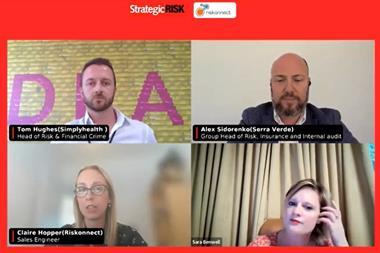In most companies over the last three years, managing threats has become at least as important as managing investment opportunities. Corporate governance failures, terrorist attacks and a series of costly natural disasters have focused senior management's attention on risk mitigation.
Enterprise value, however, is not mostly destroyed through such spectacular events, but through mundane, but common, organisational risks.
The last ice age favoured big animals with large weight to surface area ratios. But as things warmed up, these big creatures were easy prey for the smaller but faster moving carnivores of the open field. Many firms find themselves in a similar position today, moving from managing stable fixed asset businesses to more fluid, knowledge-based organisations with new and dynamic risks.
The industrial revolution was the age of big capital, in which the most productive resources were efficient factories that could exploit technical breakthroughs, new sources of energy, and abundant cheap labour. Scale and competitive advantage were integrally linked by cost advantage, and spawned ever larger and more specialised production facilities. However, these industrial platforms were not economically nimble and were sensitive to demand fluctuations. Since costs were largely fixed, profits evaporated quickly when revenues dropped,.
Like glacial ice receding, these type of industrial risks have quietly shifted. Only 15-20% of employees produce goods in the industrialised world, and the remaining capital asset risks of most companies have been transferred through lease arrangements, securitisation and interest hedges.
Cultural platform
Knowledge and creative, intelligent and team-oriented people are the critical resources which generate wealth and risk today. An organisation's cultural platform has replaced the capital platform, as the basis which drives profits and determines success or failure in business. Management guru Peter Drucker expressed the new reality by writing: 'Knowledge has become the central economic resource. The systematic acquisition of knowledge has replaced experience as the foundation for productive capacity and performance'.
The hard facts support Drucker's assertion. 75% of Dow 30's value is now in intangible, people-based assets, including knowledge, business processes and intellectual property,1) none of which are yet adequately reflected in financial statements. Various studies from consulting firms such as Marsh show that the leading causes of shareholder value collapse, whether externally or internally driven, are strategic and operational.
Analysing these findings in detail, most collapses turn out to be directly or indirectly the result of human resource failures. Managing personnel risks therefore demands top management's utmost attention.
The value of harnessing the power of an organisation's intellectual capital is many orders of magnitude greater than the incremental productivity gains from process improvements in the industrialist era. 3M's legendary success with the chance invention of the Post-it note, and Microsoft Window's monopoly are just two examples of the growth potential of well-managed knowledge organisations. However, this means that people are therefore the key risk.
Corporate cultures are slow to change. After 250 years of successful industrialist traditions, companies are only now struggling to come to grips with the risk management implications of the knowledge organisation.
The key question is whether corporate leaders recognise the importance of people-related risks, and are taking steps to mitigate them.
People risks
Personnel risks can be broadly divided into categories. Reduced productivity is the most common, subtle and measurable effect of people-based risks.
Unlike production workers, whose productivity is largely dictated by factors such as production line speed and quotas, knowledge workers largely determine their own productivity, driven by their physical and emotional condition, education, and above all, motivation. It is disturbing that employee motivation surveys routinely report that most employees are not motivated. In many cases, this lack of motivation can be traced to internal organisational issues such as poor communication, leadership problems, excessive workload, or corporate restructuring. However, external shocks, such as a terrorist attack, can also reduce motivation and productivity. These problems often lead to poor morale and extensive absenteeism.
The loss or abuse of critical information also represents a key threat to a firm's value. Modern, networked organisations have placed unprecedented volumes of sensitive information at the fingertips of more employees than ever before. Most companies' complete customer files can be simply carried out the front door in a palm computer nowadays.
Information risk can manifest itself in a number of forms. The salesman who never documents his sales contacts, or the scientist who carries specialised knowledge only in his head, are just two common varieties. And the information threat goes beyond simple loss. In an increasingly competitive business environment, the damage caused by proprietary information falling into the hands of a competitor can be catastrophic.
Intellectual property rights management is another related area of subtle, but very high risk. Years of lost R&D investment, blocked market access, litigation costs, or compensation payments threaten companies that fail to diligently and strategically manage their patent portfolios.
A company's decision-making processes also embody significant organisational and people-based risks. Power concentrations can be acceptable for making quick decisions in an otherwise risky situation. However, they themselves represent a risk for the long-term stability of networked, knowledge organisations. An overbearing decision-maker not only tends to drive other talent away; the negative consequences of losing such a leader can also be catastrophic.
Not being able to hire the right people, or hiring the wrong people, are two related personnel risks. A company which cannot attract and retain better talent than its current and future competitors, is at risk. And the damage which can be caused by a single dysfunctional employee is significant.
Emotionally unstable, or insecure personalities will not only probably make poor decisions, but can also quickly drive many talented people out of the company before the situation is rectified.
Finally, expanded employer regulation in most developed countries and employees' increased will to fight for their rights have resulted in a dramatic increase in employment litigation. Employers' practices liability is a rapidly growing area of human resource risk, encompassing sexual and other forms of harassment, discrimination and wrongful dismissal.
Employee fraud and dishonesty are also risks which arise with disturbing frequency.
Manage and mitigate
So what can companies do to manage and mitigate personnel risks? The answer is, unfortunately, not as simple as mitigating foreign currency fluctuations with off-the-shelf hedge instruments. Mitigating personnel risks requires first a systematic understanding of the risks and their relationship relative to one another and to other enterprise risks. Each company has unique personnel risks arising from its industry, culture, internal processes, organisation and the people it employs. And these must be examined within the broader context of its overall enterprise risk management process.
Nevertheless, there are a few general measures which companies can employ.
Hiring and organisational planning are among the most important. In particular, the development of a robust organisation which avoids over-dependence on just a few people for decision-making is paramount. The greater the leadership role and influence of a position, the more care needs to be taken in selecting candidates who understand the risks and have the skills and emotional maturity to mitigate them. This is clearly more difficult in smaller companies, while it places a premium on hiring people with collaboration skills. A thorough assessment process and interviews with multiple team members is an essential step toward selecting the right people.
An open, constructively critical corporate culture also helps to mitigate decision-making risks. Tolerance, with the need for critical inputs from different points of view, is more likely to lead to better, less risky decisions than those based on the narrow input of a few like-minded employees.
It also broadens the base of critical thinkers in the company, thereby reducing key-man risks. In addition, an open culture minimises the stresses which often otherwise lead to either the abrupt departure of talent or to on-the-job disengagement.
Systematic leadership processes, especially employee goal setting and feedback, are important mechanisms for minimising personnel risks at all levels. To be effective, however, feedback processes must be transparent and avoid power concentrations. They must separate private friendship from professional performance, and force a discussion on alignment of individual with corporate goals. Clearly linking individual performance with compensation and promotion opportunities is a powerful force to maintain motivation, give early warning on personnel issues, and reduce high-risk employee behaviour, even in turbulent times.
Organisational changes and re-alignment with business goals are becoming constant features of corporate survival. However, organisations naturally resist change. Personnel risks are therefore greatest at times of intense organisational change such as rapid growth, restructuring or downsizing.
This represents a key challenge for corporations and places a risk reduction premium on their ability to effectively manage the people aspects of change.
A sad but all too common example is poorly managed personnel reductions.
These may not only miss cost reduction targets but also endanger the long-term viability of an organisation if it loses critical people and skills, or irreparably damages its image in the process.
Organisational change is highly non-linear, because it is very human.
Perception quickly becomes reality. It is therefore imperative to systematically assess potential personnel risks prior to initiating changes, and prepare a plan ahead of time for mitigating them. Once change is initiated, it is often too late to give adequate consideration to the important and time-critical decisions which could have been anticipated.
Managing personnel and organisational risks in networked, knowledge-based organisations is a new and difficult challenge for corporate leaders.
It will require reconciling the complexity of human behaviour and turbulent markets with the objective of achieving stable financial returns. The solutions which emerge are likely to shape the fundamental structures, organisations and processes of tomorrow's most successful corporations.
For those which fail to adapt, the cold Darwinian fate of the woolly mammoth awaits.
1) Dow Jones Industrial Average companies 5 September 2003
Simon Kuenzler is manager, risk consulting and ART, Kessler Consulting, Tel: +41 1 387 88 66, E-mail: simon.kuenzler@kessler.ch, Andros Payne is chief executive officer, Humatica, Tel: +41 1 955 11 01, E-mail:
andros.payne@humatica.org
PEOPLE RISK STRATEGIES
- Focus on hiring and organisational planning
- Establish a constructively critical corporate culture
- Embed systematic leadership processes, especially goal setting and feedback
- Manage organisational change and re-alignment with business goals
- Systematically assess potential personnel risks


















